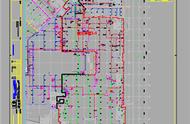
语法梳理:王兴刚老师
适合人群:英语教师、英语专业学生、初高中生等
在我们学习英语的过程中,类似的难点很多。其实这类问题产生的原因,都是二语习得的过程中,过分依赖母语表达习惯产生的。
英语中的每个词,都有他们的特定使用场景。这个场景如果恰好与中文重合,那么我们接受起来就容易。如果不是完全重合,那么接受起来就困难。类似的还有瞬间性动词啊,双重所有格啊等等。
Across和through的中文含义都是通过、穿过,甚至英文词条解释都是from one side to another。所以困惑也就可以理解了。
现在我们来正式讲解一下
一、牛津字典中的词条- Across
Preposition(此文只讲介词,与through对比。不讲副词。)
From one side to the other of something. Expressing movement over a place or region.
eg:
I ran across the street.
Travelling across Europe.
- Through
Preposition(此文只讲介词,与across对比。不讲副词。)
① Moving in one side and out of the other side of an opening, channel, or location.
eg:
Stepping boldly through the doorway.
② So as to make a hole or opening in a physical object
eg:
The lorry smashed through a brick wall.
③ Moving around or from one side to the other with a crowd or group.
eg:
Making my way through the guests.
④ So as to be perceived from the other side of an intervening obstacle.
eg:
The sun was streaming in through the window.
结论:
从词条的解释我们可以看出,through的应用场景是非常具体的。具体到四种情形:隧道的穿行,破墙而入,人群穿行,穿过障碍,越过障碍。
而across只强调从一边到另一边。其实这个一边到另一边也有具体的定义,因为下文要展开说,所以这里只简单说一下。是从一个物体的一边到另一边,完成对于物体表面的跨越。

- 第一组
I went ACROSS the desert.
I went THROUGH the desert.
Technically, both could be correct, depending on context. If you start at one side of a desert and go all the way to the other side, then you go "across" the desert. However, for instance, you start a journey at one side of the desert but after 20km, you are collected by helicopter (!). You would say that you Walked through the desert, until you found the helicopter.
解释:
对于沙漠来说,through和across都可以。如果成功穿越,用across。如果半途而废,那就是“借道”的意思,就用through。我从沙漠里走了,直到看到直升机,我就撤了。
- 第二组
"Walk through the tunnel"
"Walk across the tunnel"
"Walk through the tunnel" means to enter the tunnel on one end and emerge out the other end.
"Walk across the tunnel" could mean the same thing, but only if the context establishes that. It could also mean to enter the tunnel through a side entrance, and exit out another side entrance (i.e. the short way, not the long way); or it could mean to go across the top of the tunnel (e.g. if it's underground and the road goes over it); or variations on those themes.
In general, "through" implies entering the middle of something and then going out the other side, whereas "across" implies crossing the middle, but not necessarily going in the thing you're crossing.
解释:
Through强调的是“进入-出来”,强调的是the long way顺着长边
Across强调的是“表面通过”,强调的是the short way切割短边
总结:只有当产生“in”的感觉,才能用through。
- 第三组
The difference between through and across is that Through is used to describe movement in three-dimensional space. It is also used to describe the inward movement.
About grass and lawn, if we are talking about a place which is covered with tall or long grass, we should use "through":
When my dog runs through long grass, it’s difficult to find him.
but if we are talking about a field covered with short or small grass or lawn, we should use "across".
解释:
对于草坪、草地等场所,看草的高度。如果你觉得草很高,那就用through,如果草很短,那就用across。
- 第四组
Across, as the name suggests, it is used to talk about the transverse movement of a person or object. As against, through is used to denote a movement from one side of the passage, towards the other side.
She walked through the pool.
She walked across the pool.
At first instance, the two sentences often appear the same to us, but if you check their literal meaning, then you will understand the real difference between these two. In the first example, the word ‘through’ means by way of, whereas in the second example ‘across’ means side to side.
解释:
英文解释用by way of和side to side两个短语,有点不容易理解。
Through:侧重的是通过,游贯通。强调的是把pool当成一个方式和途径。
Across:侧重的是边界,从这边游到了对岸。强调的是两岸横跨。
总结:through是向着另一侧通过,不强调抵达。而across则指完成从一边到另一边。这个解释,跟之前的desert的例句很像。
- 第五组
Across, as the name signifies, it indicates the crosswise, arrangement or movement of something, i.e. from one end or side to the other. On the other hand, the word through refers to in and out of something which is an enclosed space.
We use the word ‘across’ when there is a movement in two-dimensional open space, i.e. a field, ground, bridge, road, etc. Conversely, ‘through’ is used when the movement takes place in three-dimensional closed space, i.e. tunnel, doorway, forest, etc.
Across
- The dog ran across the garden and then disappeared after some time.
- That house across the street belongs to my uncle.
- I came across your profile suddenly.
Through
- Amar was penalized for driving through a red light.
- Our car passed through the tunnel.
- He hit the nail through hammer.
解释:
使用across,场地是扁平的,人或物的运动是在二维平面。
使用through,场地是立体的,中空的,四周都有边界,形成立体合围。比如隧道,灌木丛,人群,大门,森林等等。人或物的运动是在三维立体空间产生的。

通过以上字典中的词条解释,以及实际应用中的老外解释,我们不难发现一些规律。现在王老师把这些规律,总结出来。
一、整体原则
1. across:表面、二维、强调跨越感
2. through:内部、三维、强调途径感
二、细分逻辑
1. 【地面和空间结合的场所】
对于明显产生合围、形成立体空间,且人或物从中穿行,要用through;但不从中穿行,而强调从表面越过,要用across。常见的场景有房门、人群、隧道、森林等。
比如人走过森林要用through,但飞机从森林的一边飞到另一边要用across。














